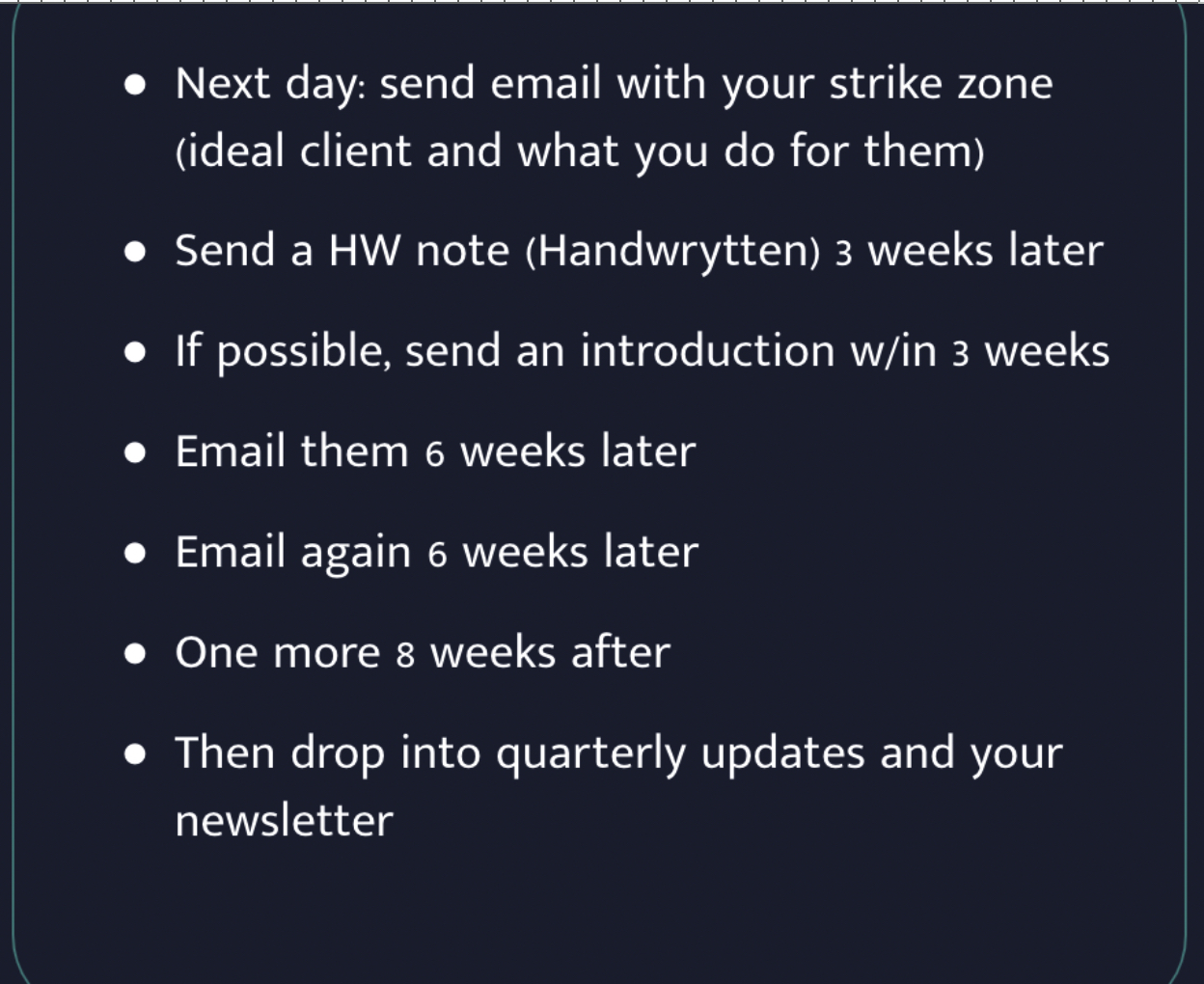Networking Like a Pro: 6 Must-Take Actions for Referral Success

Some businesses run on referrals.
It’s usually because:
A. Actually a lower cost of sale to have people refer business to you than search for those deals one by one;
B. The service is purchased based on trust (consulting, law, etc…);
C. Someone’s afraid to prospect.
Let’s skip category C for now, and focus on A and B.
In a situation like factoring – where a business sells their receivables for funding their operations – it’s dadgum hard (and expensive) to cold call your way to finding the right prospects there. It’s easier and less expensive to call on bankers who see those deals and can’t do them.
In a situation where the service is based on trust, like consulting, business gets done so much faster because someone tells their buddy at another company, “I know Adam.”
It’s not the same as saying, “I worked with Adam and it was great for our business,” but it’s still effective.

(Quick note: when I was with Market Sense, from 2008-2017, I estimate we worked with something like 60 or so companies that were in Entrepreneur’s Organization. Talk about a word–of-mouth machine.)
If you’re in any of these categories (even the people in C), your business requires a lot of networking, building and maintaining relationships.
How do you make all your networking work for you?
Well, grasshopper, I’m glad you asked. Because I’m here to help.
Read on for my 6 steps to making referrals work.
So what do you need to do to drive referrals from your networking?
__________________________________________________________________________________________________________________
1. Fix your messaging. It can’t suck.
In high school, we were winless when one of our coaches told us, “Everyone says you suck. Just don’t suck.”
Easier said than done. We finished 0-10. And were shut out 4 times.
Most people, in their networking, sound like EVERYONE else who is in the same space.
“We are a full-service _________ company.”
“I’m a __________ attorney.”
“We provide managed IT services.”
Just stop, please.
If your competitor says it the same way, you’re in trouble.
Your message needs to fit inside a part of your audience’s brain where they’ll keep it safe and sound.
It’s much more effective to say, “I help building owners find new tenants” than it is to say, “I’m a full service commercial real estate company.” Why?
Who else knows what “full service” means in your industry other than coworkers and competitors?
Speak to something that your referral sources will understand and remember and you’re started.
Pro tip: the more specific you are, the better.

__________________________________________________________________________________________________________________
2. Know your referral sources.
One of the most impressive things I’ve seen was the detailed notes a client took on ME.
Years ago, I partnered with a former client. When I got into his CRM, I saw the notes he and his team had taken on me – personally.
And I’d been their consultant!
They had recorded my hobbies, where I was from, my kids’ names and ages.
Creepy? Nope.
I was impressed.
This makes managing more relationships better…easier.
It also is an example of how seriously the company took relationships (they did all their business via referral, if that tells you anything).
The more you know about your contacts, the more they’ll trust you because they feel, well, known.
__________________________________________________________________________________________________________________
3. Stay in front of your referral sources.
This should be obvious. But it’s not. I hear people say, “I do so much networking…”
And they sound like my kids who say, “I do EVERYTHING around here” while their mother and I roll our eyes.
The first contact with a potential referral source – likely at a luncheon, over coffee or at a happy hour – rarely turns into something.
It’s only after several impressions that most people are comfortable making introductions.
Here, you’re better off being a mile deep and an inch wide than vice versa. You want to really get to know the right people.
So build a system to stay in front of them.
Here’s the process I put together at one point in my career:

That seems pretty simple, right?
It was. And two years after I left that industry, I was getting referral calls because of the work I’d put in. People knew me as the guy who ________________.
__________________________________________________________________________________________________________________
4. Feed ‘em
People tend to help those whom they feel indebted to. Read Cialdini or Robert Greene, and you see the psychological backing for this.
This does NOT mean walking someone you just met into the center of your network to your most sacred relationships.
Nor does it mean you are obligated to introduce them into their ideal client.
It does mean that you want to connect them to other people…. People with whom they can likely find some way to collaborate, work together, or just network.
They’ll see that you “went first” and made an introduction. Guess what you should be looking for?
__________________________________________________________________________________________________________________
5. Keep score, part 1
If you have a core need in your business, you don’t want to be at the mercy of 1 supplier. Ideally, you have one who gets 70% of your business, 1 who gets 20%, and one who gets 10%. Why?
If the guy in pole position gets feisty on pricing, you can bump #2 into that spot.
If you’re networking, you’ll likely meet several people who do the same thing: banking, law, tax, consulting, benefits, etc…
Make a note of the introductions you make to people.
And make a note of those they send your way.
At a certain point, check the ledger. If you’re sending banker A quite a few referrals or connections, and not seeing any (or enough) come back, it might be time to bump banker B into the top spot.
It sounds very capitalist. In a way, it is.
But your relationships and introductions are valuable. And should be reciprocated.

__________________________________________________________________________________________________________________
6. Keep score, part 2
You probably won’t mail out referrals to people who don’t reciprocate forever. But you’ll keep them on your email list, or your network.
Just because they don’t send you anything – that doesn’t make them bad people.
But you do need to roughly track – in aggregate – in something like this format:
Those who don’t send anything at all
Those you’ve met, not connected with significantly, but believe have potential
Those who have sent one referral
Those who have sent several referrals
Those who have sent multiple referrals that have turned into business
Why this way?
Because you will want, at various times, to send various messages to those different groups.
You’ll treat those segments somewhat differently.
Those sending you several referrals who have turned into business – they’re likely to do the same. You need to put MOST of your efforts into keeping those people happy and feeling loved.
__________________________________________________________________________________________________________________
Building a referral generating machine isn’t rocket science.
It just requires effort. Like anything else.
And a CRM. Without cobwebs.
So get it rolling.
Questions on this?
Email me: adam@thenorthwoodgrp.com

